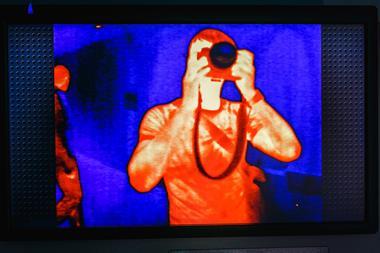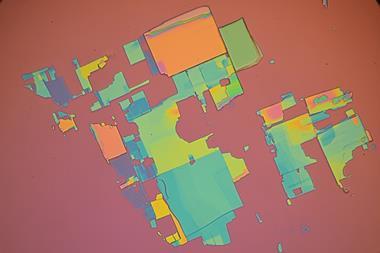
A new artificial retina based on the 2D materials graphene and molybdenum disulfide offers significant advantages over current retinal implants aiming to restore sight to blind people. Animal studies of the prototype have shown promise, and the technology also has applications for monitoring heart and brain activity.
As conventional retinal implants are silicon-based, they are rigid and flat, and therefore can distort vision and damage the retina, as well as the optic nerve. In search of a better option, a research team led by University of Texas at Austin material scientist Nanshu Lu and colleagues at Seoul National University in South Korea, built a hemispherical soft implantable optoelectronic device using molybdenum disulfide as the photosensitive semiconductor, graphene as the interconnector and thin layers of gold, alumina and silicon nitrate to make the array especially flexible and dense. As the total thickness of the material is only 1μm, it fully conforms to the shape of the retina.
‘Using this kind of high density phototransistor array, we are able image external light stimulations and convert that into electrical stimulations, and we have also ultrasoft and conformable electrical stimulators that can stimulate the optical nerve,’ Lu explained as she presented the work at the 256th American Chemical Society meeting in Boston, US. After implanting the artificial retinas in rats, the researchers also attached an external controlling circuit. Electrodes in the rats’ brains were able to measure the optical versus electrical stimulation spikes.
‘We can measure the light stimulation to your phototransistor, then we also have this electrical neuro-stimulating interface to stimulate the retina such that we can use to measure those elicited spikes in the brain,’ Lu said. When the researchers compared the optically stimulated spikes with the electrically stimulated spikes, they were very similar.
‘You can see that the electrical stimulation can really mimic the optical stimulation in terms of your brain activity,’ Lu noted. ‘Therefore, we have proven that this could be a real artificial retina by first sensing light, and then converting the light to an electrical signal, and then using this electrical signal to stimulate the optic nerves, and finally measuring the brain waves stimulated by those electrical signals, which can fully mimic the real light stimulation.’
The team has taken its work further to demonstrate another example of soft 2D material-based bioelectronics. The researchers placed these same sensors on the surface of the faces of human research participants, who were then able to remotely control a drone with their eye movements. A laptop can receive wireless electrooculogram (EOG) signals from the surface of the electrodes, and use these to control the drone based on the direction the person rotated their eyes. ‘There is no camera on the drone, the drone is purely controlled by the laptop, which is measuring the EOG signals from the surface of his face,’ Lu explained.
However, considerable work remains to get the team’s artificial retina to achieve real human vision in terms of pixels and colour matching. In addition, cost remains a concern because 2D materials like molybdenum disulfide are much more expensive than silicon and harder to fabricate.















No comments yet